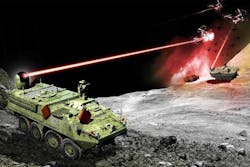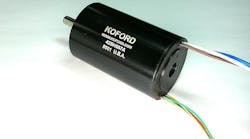ARLINGTON, Va. – U.S. military researchers are asking industry to develop affordable high-energy laser sources for future laser weapons that can destroy or disable enemy unmanned aerial vehicles (UAVs).
Officials of the U.S. Defense Advanced Research Projects Agency (DARPA) in Arlington, Va., issued a broad agency announcement (HR001122S0017) late last month for the Modular Efficient Laser Technology (MELT) program.
MELT seeks to develop a compact, scalable, actively coherently beam combined semiconductor laser source with excellent beam quality to create a mass-producible, low size, weight, and power (SWaP) scalable laser source.
MELT aims to capitalize on technologies such as semiconductor fabrication techniques, coherent beam combining, photonic integration, and 3D integration and packaging.
Related: Directed-energy weapons taking big steps forward
Today’s laser weapons that use multiple beam-combined high-power fiber amplifiers as the high-energy laser sources, as well as large complex optical subsystems that condition and project the laser beam do not scale well, DARPA researchers say.
On the other hand, coherent beam combined tiled array high-energy laser sources are scalable because they eliminate these large subsystems.
Coherently beam combined tiled arrays offer a path to better high-energy laser sources because of the ability to generate and project the laser beam directly without bulk optics; the intrinsic scalability of a tiled array with no inherent limits; the ability to perform non-mechanical beam steering for beam jitter corrections; and the ability to apply complex phase corrections to compensate for atmospheric disturbances.
The proliferation of small, low-cost unmanned aerial vehicles (UAVs) on the battlefield requires a layered defense that includes low-cost laser weapons. The deep magazines of laser weapons are suited to counter swarms of hostile UAVs, and have the potential to achieve very low operating cost -- assuming low production costs can be achieved. Counter-UAV and similar applications need a broad range of power levels from a few kilowatts to megawatts, which isn't possible today.
Related: At long last, laser weapons are nearing deployment
Instead, MELT seeks to develop a laser tile as the building block for compact, scalable, panelized laser weapons. The laser tiles will integrate into planar arrays for scalable laser weapons with comparable or better performance than current laser weapons.
MELT seeks to demonstrate a 3-by-3 panelized array of laser tiles with excellent beam quality as a scalable high-energy laser source.
The mass, volume, and size goals for the laser tiles and panelized array of laser tiles include the semiconductor amplifier emitters, optics, phase sensing and control, power delivery, power conversion, thermal dissipation, computing, external connections, inter-tile electrical, coolant, and data connections.
Each MELT tile will contain a 2D array of laser emitters whose phase can be sensed and controlled continuously to achieve coherent beam combination. For scalable output power, several to several hundred of these tiles may be arranged as a panelized, gimbal-mounted laser weapon source that produces a usable output beam.
The DARPA MELT project has three technical challenges: a dense planar tiled array of amplifiers with uniform spacing and emission normal to the 2D surface; realizing a scalable phase sensing architecture for a panelized high-energy laser source; and realizing a compact scalable cooling solution to remove the anticipated thermal load from a panelized high-energy laser source.
The MELT program will be a five-year $60 million program. All proposals in response to this BAA must address all three phases.
The goal of this program is to develop a mass-producible, low SWaP, scalable laser source. This will require the development of a new type of high-energy laser source. The MELT program is interested only in semiconductor diode-based laser technologies that do not include optically pumped brightness converters.
Companies interested should upload abstracts no later than 7 March 2022, and full proposals no later than 2 May 2022 to the DARPA BAA website at https://baa.darpa.mil.
Email questions or concerns to Thomas Ehrenreich, the DARPA MELT program manager, at [email protected]. More information is online at https://sam.gov/opp/11dc6b43a8ef4723ae5e004c29537c99/view.



